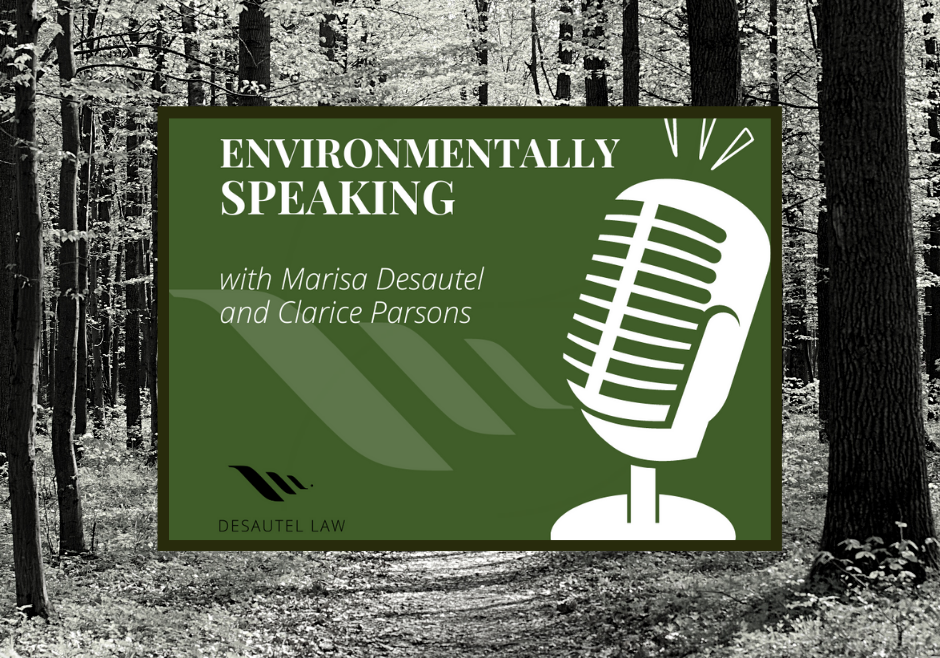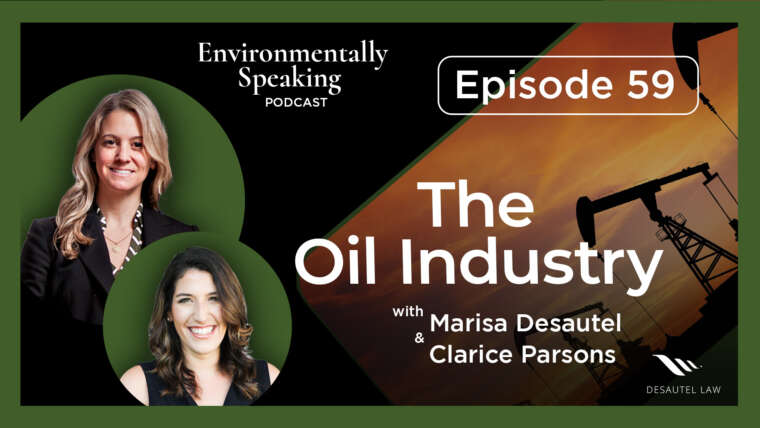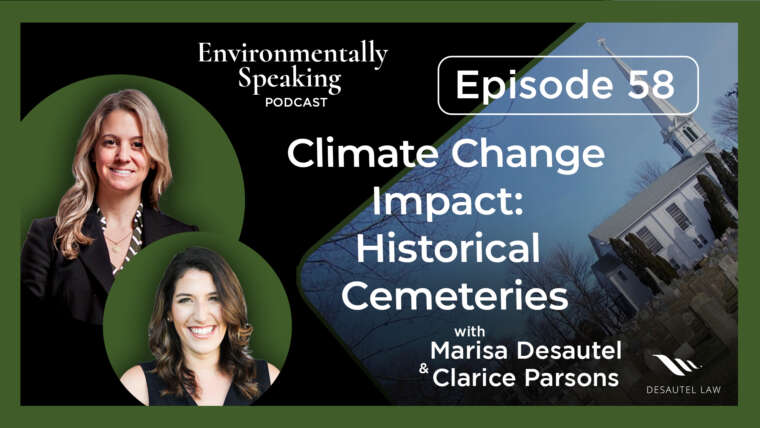On this episode of Environmentally Speaking, Marisa and Clarice discuss environmental law and litigating regarding water discharging.
LISTEN NOW:
EP 015 – Storm Water Discharging
CLARICE: Good morning, everybody.
MARISA: Oh, you’re saying good morning as though everyone’s listening to this before noon.
CLARICE: Oh, that’s true.
MARISA: Yeah.
CLARICE: Well, I’m having a good morning. I don’t know what type of day you’re having.
MARISA: [inaudible]. This is Environmentally Speaking. I am Marisa Desautel an attorney with a few decades of experience.
CLARICE: Hello. And I’m Clarice. I’m bringing your questions and topics to the table to discuss. And conveniently this week, Marisa, you had a topic and my husband had the same topic. So, you know, just satisfying all the listeners, all three of you guys.
MARISA: It’s a topic that we’ve already discussed in a previous podcast but in more general terms. And for whatever reason it kept coming up with clients last week and I spoke at a conference of this same topic. It is strange how the industry seems to move in a direction together at a certain time. For whatever reason stormwater is it right now, but at other times of year it’s the Land Revitalization Program or Brownfield’s redevelopment or clean air. This past week has been the Clean Water Act and stormwater discharges.
CLARICE: I wonder if it has anything to do with the fact that we’re like just getting out of tropical storm season.
MARISA: Yeah. I’m sure that definitely has something to do with it. And municipalities are looking into getting legal advice on how to update some of their stormwater programs, so it could be that they’re getting feedback or directive from the state about that issue, so maybe it’s being driven by government. I’m not sure. I have not asked that question. But in any event, we thought it was –
CLARICE: ?? Big government.
MARISA: Yeah.
CLARICE: Just the general government.
MARISA: Yeah. So we thought talking about it – and by we I mean Clarice and me – in terms of the municipal angle because our previous podcast was more of a general post storm surge discussion and the municipal side has more to do with day-to-day operations and maintenance for stormwater.
CLARICE: Let’s start with that.
MARISA: Okay.
CLARICE: Dig day sounds like – that sounds exciting. It also sounds very much like demo day and I have been watching a lot of home reno shows. So tell me dig day is just as fun.
MARISA: There are no sledgehammers involved, so I’m sorry about that.
CLARICE: Already out.
[0:02:50] MARISA: An immediate disappointment for you. There are, however, less exciting passive day-to-day operations that these stormwater infrastructures are subject to. The interesting thing in a nerdy capacity about the municipal stormwater programs are that they’re not as enforceable as some of the other programs under the Clean Water Act because stormwater is very difficult to regulate. In the past I’ve referred to it as like trying to herd cats. Stormwater is not a discreet conveyance, necessarily, and it flows over land in a sheet. It’s not channeled. It’s not necessarily diverted because when rain falls it covers a giant area. And so water either gets saturated into the ground or runs over the ground once the soil is fully saturated and can’t accept anymore water. The stormwater flows from high point to low point.
CLARICE: And I think that’s already a good point because when I hear stormwater I instantly think how the roads are sloped in a way to encourage the rain to go along the edges of the road into the storm grates.
MARISA: That’s right.
CLARICE: But bigger picture, you know, there’s things that we don’t think about like the rain that’s coming from our yard and our yard doesn’t have a natural slope to a grate, or, you know, maybe it’s a parking lot or a field, or. You know, stormwater is bigger than what’s just running down our street and the puddles we’re stepping in, so that’s already a shift in perspective.
MARISA: Yeah. Yeah. That’s a really good point. The difference between the street scenario and, let’s say, your yard scenario that you’re talking about is the difference between what’s called pervious and impervious surface. An impervious surface is anything that’s paved, lined with pavers or concrete or some type of substance that does not allow water to make its way into the ground. And a pervious surface is, for example, a field or your lawn or any area that’s not modified with some type of material that forces the water to keep it moving essentially. And the entire purpose of the municipal stormwater infrastructure system is to ultimately collect the water that is landing on an impervious surface because if you didn’t have a collection system the water would just pond in the street and you wouldn’t be able to drive.
CLARICE: I’m definitely surprised with town that’s still a problem.
MARISA: Right. Yeah.
CLARICE: I’m just thinking about the pond that, you know, sometimes if it’s raining I’m like, all right, I don’t need to go to that part of town.
[0:06:09] MARISA: Right. Well, that’s because probably the town is not keeping up with its –
CLARICE: Keeping up with it.
MARISA: — stormwater collection system. So when I was talking earlier about how the enforcement of the municipal stormwater collection program is difficult, the herding cats example, is because the way that the federal Clean Water Act is written allows for regulation and enforcement of stormwater only when it’s a discreet conveyance. What the heck does that mean?
CLARICE: No idea.
MARISA: That means when stormwater is channeled to such an extent that it only has one discharge point, either the end of a pipe or another type of outlet, something that you can physically go and collect a sample from. Does that make sense?
CLARICE: So that would be – would the street being curved to force the water into the storm drain, would that be a point, or is that still too far removed from the pipes?
MARISA: I’m pretty sure that it’s still too far removed. The only reason I say I’m pretty sure is because case law in this area is rapidly changing. Stormwater is the last bastion of the Clean Water Act that everyone is still struggle with to try to figure out how to better manage and regulate. So a lot of the process forward is coming out of litigation where mostly federal courts are looking at case-by-case scenarios and making a determination about what constitutes a discreet conveyance. So that’s a good question.
CLARICE: So going back to your point of needing to meet the water at a collection point where you can get a sample, what’s the importance of that for the municipality?
MARISA: The state and federal government can issue an enforcement action when they know that there’s a violation under the Clean Water Act of a particular numeric criteria. Each pollutant contemplated by the Clean Water Act has an action limit. So let’s take phosphorus, for example. If you are discharging phosphorus above the action limit into a discreet conveyance or to a discreet conveyance, excuse me, you can be cited by the government for that because you shouldn’t be discharging phosphorus above a certain amount.
In terms of the municipal side, the way that municipalities are regulated for stormwater is a different process because you don’t necessarily have a discreet conveyance. The government has decided instead to require municipalities to undertake certain best management practices and minimum control measures. And those are more narrative in nature. There isn’t necessarily an action limit associated with the narrative. And by narrative I mean the town has to come up with something called an MS4 permit application where they agree to certain best management practices including street sweeping, let’s say, four times a year or cleaning out the catch basins a certain number of times a year.
So that’s why on any given – not any given day but in your own town you might be driving along and all of a sudden you see this giant street sweeper with a brush. It’s usually a circular brush that someone is driving a big piece of equipment with and you see the brush circulating along the curb. That’s street sweeping and they’re cleaning up salt, silt, sand, trash, and other degree, getting it out of the road so that it doesn’t make its way into the catch basin. That’s how municipalities are regulated under the Clean Water Act. They’re more narrative. They’re more – less sampling and enforcement and more make sure you go out and maintain the infrastructure that exists.
[0:10:40] CLARICE: And is that just because, I mean, essentially stormwater is – I’m going to say it’s almost uncontrollable. It’s coming from the sky. It’s coming off your roof. And, you know, on its way it’s just picking up a little bit of everything.
MARISA: Yeah.
CLARICE: So is that why it’s more focused on best practice try to keep it clean versus more focused on these numbers and these metrics [inaudible] just because it’s coming from everywhere and it’s –
MARISA: Yes. Yes.
CLARICE: — so much more uncontrolled?
MARISA: The municipalities would be cited every single day if there were a numeric criteria because, you’re right, the municipal collection systems are capturing stormwater runoff from everywhere, commercial, industrial, residential, the streets themselves, so it would be very difficult for the municipality to figure out how to get rid of all of those pollutants. And keep in mind that your – you just mentioned roof. As a residential property homeowner, you are not regulated by the Clean Water Act. Whatever comes off of your roof is not – the government is not going to come out and cite you for some kind of violation of the Clean Water Act for that. Residential buildings are not necessarily contemplated.
CLARICE: Thank God. That’s where I keep my open tubs of phosphorus, so it would be terrible.
MARISA: That’s a good point.
CLARICE: I think this is one of the first cases that I worked on when I started working with you. I remember it was – our client had a construction company and as part of that there was a lot where he kept, you know, different types of gravel and stone and things that, you know, obviously go into the building of homes and the landscaping. And I remember there was a discussion about the – what was it. It was the runoff water.
MARISA: Yeah.
CLARICE: So basically the stormwater and it was collecting from, you know, his rocks and his equipment and things like that. So I think that’s where this all started for me. I was like, oh, it’s traveling from everywhere and just picking stuff up as it goes.
MARISA: Yeah.
CLARICE: It’s a hoarder.
[0:12:59] MARISA: And in that case the Plaintiff was alleging that there was a discreet conveyance, so a little different from what we just talked about with the municipalities. But, yeah, I mean, that’s a real-world example of how the Clean Water Act can be used as an enforcement tool against a discreet conveyance. If you don’t have a discreet conveyance and a discharge to a water of the state, then there’s no violation of the Clean Water Act. You have to have three things. There has to be a pollutant. It has to be discreetly conveyed. And then it has to be conveyed or discharged to a water of the state. So that’s the trifecta or the holy trinity. Amen.
CLARICE: I was going to say the three bases for the homerun.
MARISA: True. Another good analogy.
CLARICE: That is my only sports analogy, so you’re welcome, everybody.
MARISA: Great.
CLARICE: I think that’s baseball. We don’t actually know. So is there anything else that we should talk about in terms of municipalities? And, you know, they’re trying their hardest.
MARISA: They are, yeah. In my experience they are. It’s a difficult area of law and they’re trying to comply the best they can.
CLARICE: [inaudible] coming up so often in case law and it’s changing, are you seeing any trends coming or are municipalities leaning one way or another?
MARISA: No. The case law really has more to do right now with industrial and commercial activity, what can be defined as a discreet conveyance. For example, mining operations, that’s a pretty common area that you see companies and private parties litigating or municipalities litigating, you know, from mining operations. When is that treatment water moved or flowing to such an extent that it can be defined as a discreet conveyance, so that type of thing. Municipalities not so much.
CLARICE: Okay. That makes sense.
MARISA: Yeah.
CLARICE: I think right now we’re in an area where mining is not so huge, but I can see that being a big deal more towards the middle of the country.
MARISA: That’s right, exactly right.
CLARICE: All righty. Well, everybody, that’s municipalities and stormwater. And, you know, don’t put your phosphorus on your roof. That’s kind of the big takeaway today.
MARISA: Thanks, Clarice. Thanks, everybody.
CLARICE: All righty. If you have any questions or comments, please send them in at Help@DesautelESQ.com. Hit us up on Instagram. You can comment. You can DM us your questions, your topics. And thanks for hanging out with us.
MARISA: Thanks. Bye.




